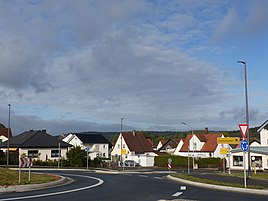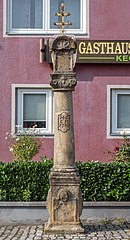Köttmannsdorf (Hirschaid)
|
Köttmannsdorf
Hirschaid market
Coordinates: 49 ° 48 ′ 24 ″ N , 10 ° 57 ′ 51 ″ E
|
|
|---|---|
| Height : | 249 (244–260) m above sea level NHN |
| Residents : | 641 (Dec. 31, 2019) |
| Postal code : | 96114 |
| Area code : | 09543 |
|
The Hirschaid district of Köttmannsdorf
|
|
Köttmannsdorf is a Franconian village that belongs to the Hirschaid market .
geography
The village , not far from the left bank of the Regnitz , is one of eleven officially named municipal parts of the Hirschaid market in the southeastern part of Upper Franconia . The center of Köttmannsdorf is about two kilometers southwest of the center of Hirschaid at an altitude of 249 m above sea level. NHN .
history
The first written mention of the place had taken place in 1109 under the name "Chotemaresdorf", which corresponds to the meaning as "village of the Cotemar". Until the beginning of the 19th century had the village denunciation of Köttmannsdorf the sovereignty of direct imperial nobles were subject, resulting in the the Frankish knights circle belonging Ritter Canton Gebürg had organized. The village and community rulership, which is decisive for the successful claim of sovereignty in the Franconian region , was exercised by the von Soden noble family, who owned the Sassanfahrt manor . The history of Köttmannsdorf was closely linked to the history of the manor, to which the village belonged during the entire existence of this imperial territory. The perception of the high courts , however, was to the Bishopric of Bamberg belonging cents Office Bechhofen to. When the rich knightly territories as a result of Reichsdeputationshauptschluss circuit mediates were Köttmannsdorf was in violation of the constitution on Nov. 1, 1805 from the Electorate Palatinate-Bavaria annexed. The village thus became part of the New Bavarian territories that were taken over by the "Napoleonic land consolidation" , which was only subsequently legalized in July 1806 with the Rhine Confederation Act.
As a result of the administrative reforms in the Kingdom of Bavaria at the beginning of the 19th century , Köttmannsdorf became part of the independent rural community of Sassanfahrt , to which the hamlet of Juliushof still belonged, with the second municipal edict in 1818 . In the course of the municipal regional reform in Bavaria in the 1970s, Köttmannsdorf was incorporated into Hirschaid together with the municipality of Sassanfahrt on May 1, 1978. In 2019 Köttmannsdorf had 641 inhabitants.
traffic
The state road St 2260 coming from Röbersdorf runs past the southwestern edge of the village and continues via Sassanfahrt to Hirschaid. The public transport serving the village at a bus stop of bus number 978 of the VGN . The nearest train station is in Hirschaid on the Nuremberg – Bamberg railway line .
Attractions
In Köttmannsdorf there are two listed objects, namely a sandstone wayside shrine and a wrought iron cross.
literature
- Hildegard Weiss: City and district of Bamberg (= Historical Atlas of Bavaria, part of Franconia . I, 21). Commission for Bavarian State History, Munich 1974, ISBN 3-7696-9884-3 .
- Johann Kaspar Bundschuh : Köttensdorf . In: Geographical Statistical-Topographical Lexicon of Franconia . tape 3 : I-Ne . Verlag der Stettinische Buchhandlung, Ulm 1801, DNB 790364301 , OCLC 833753092 , Sp. 192 ( digitized version ).
- Herbert Popp , Klaus Bitzer, Halk Thomas Porada: Franconian Switzerland . Ed .: Sebastian Lentz , Bernhard Müller (= Landscapes in Germany ). Böhlau Verlag, Vienna, Cologne, Weimar 2019, ISBN 978-3-412-51535-5 .
- Gertrud Diepolder : Bavarian History Atlas . Ed .: Max Spindler . Bayerischer Schulbuch Verlag, Munich 1969, ISBN 3-7627-0723-5 .
- Sigmund Benker, Andreas Kraus (Ed.): History of Franconia up to the end of the 18th century . 3. Edition. Beck, Munich 1997, ISBN 3-406-39451-5 .
- Federal Statistical Office (Hrsg.): Historical municipality register for the Federal Republic of Germany. Name, border and key number changes in municipalities, counties and administrative districts from May 27, 1970 to December 31, 1982 . W. Kohlhammer, Stuttgart / Mainz 1983, ISBN 3-17-003263-1 .
Web links
- Köttmannsdorf in the Topographia Franconiae of the University of Würzburg , accessed on May 19, 2020.
- Köttmannsdorf in the Bavarian Authority Guide , accessed on May 19, 2020
- Köttmannsdorf in the BayernAtlas , accessed on May 19, 2020
- Köttmannsdorf on a historical map , accessed on May 19, 2020
Individual evidence
- ↑ a b Population of Köttmannsdorf on the Hirschaid market website , accessed on May 19, 2020
- ^ Köttmannsdorf in the local database of the Bayerische Landesbibliothek Online . Bavarian State Library, accessed on May 19, 2020.
- ↑ Geographical location of Köttmannsdorf in the Bavaria Atlas , accessed on May 19, 2020
- ↑ a b History of Köttmannsdorf on the Hirschaid market website , accessed on May 19, 2020
- ↑ Franconian Switzerland . In: Landscapes in Germany . S. 66 .
- ↑ Gertrud Diepolder : Bavarian History Atlas . Ed .: Max Spindler . Bayerischer Schulbuch Verlag, Munich 1969, ISBN 3-7627-0723-5 , p. 31 .
- ↑ Gertrud Diepolder : Bavarian History Atlas . Ed .: Max Spindler . Bayerischer Schulbuch Verlag, Munich 1969, ISBN 3-7627-0723-5 , p. 97-103 .
- ↑ a b Bamberg city and district . In: Historical Atlas of Bavaria . S. 138 .
- ^ A b Johann Kaspar Bundschuh : Köttensdorf . In: Geographical Statistical-Topographical Lexicon of Franconia . tape 3 : I-Ne . Verlag der Stettinische Buchhandlung, Ulm 1801, DNB 790364301 , OCLC 833753092 , Sp. 192 ( digitized version ).
- ^ City and district of Bamberg. In: Historical Atlas of Bavaria . Supplement to the card “Offices at the end of the Old Kingdom” .
- ^ City and district of Bamberg . In: Historical Atlas of Bavaria . Supplement to the card “High dishes at the end of the Old Kingdom” .
- ↑ Gertrud Diepolder : Bavarian History Atlas . Ed .: Max Spindler . Bayerischer Schulbuch Verlag, Munich 1969, ISBN 3-7627-0723-5 , p. 35 .
- ↑ Gertrud Diepolder : Bavarian History Atlas . Ed .: Max Spindler . Bayerischer Schulbuch Verlag, Munich 1969, ISBN 3-7627-0723-5 , p. 106-107 .
- ^ City and district of Bamberg . In: Historical Atlas of Bavaria . S. 263 .
- ^ Federal Statistical Office (ed.): Historical municipality directory for the Federal Republic of Germany. Name, border and key number changes in municipalities, counties and administrative districts from May 27, 1970 to December 31, 1982 . W. Kohlhammer, Stuttgart / Mainz 1983, ISBN 3-17-003263-1 , p. 673 .


